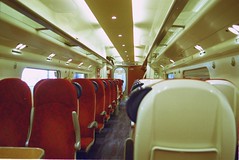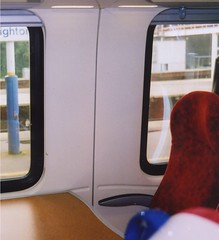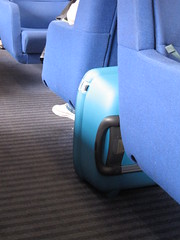The Inter-City 125 fleet has done the railways well, but it should not be forgotten that bicycle restrictions came with these trains as they were designed to run in fixed formations - they had little van space in their original form and it is not easy to add on carriages at short notice, as used to be common practice if a large crowd turned up. And the size and spacing of the windows of the mark 3 coach mean that there are always a number of window seats which have no window, but a piece of plastic in the line of sight, and the windows themselves are too high. So I have never been a great enthusiast for HSTs. Nevertheless, compared to recent stuff like Voyagers and Pendolinos, they are wonderful.
However, First Great Western's scheme to shorten and reconfigure the interiors of its HST fleet seems inappropriate in view of the present trend of growing passenger numbers. Surely FGW should be planning for this? Trains need to be lengthened rather than shortened. We have a window of opportunity to do this at low cost with the spare mark 3 vehicles that are currently available and will otherwise go for scrap.
If the aim is to increase acceleration, then all that is necessary is to re-gear the power cars as part of the modernisation package. This will reduce top speeds, but with present-day traffic patterns with stops about 25 miles apart or less, the effect on overall journey time will be minimal and a robust timetable can still be achieved.
The need to cram in as many passengers as possible by using airline seating may not be received with as much enthusiasm as MD Alison Forster expects. Given adequate legroom, unidirectional seating is obviously acceptable to passengers going by themelves, especially on a route they use freqently - they plug in their i-Pods and laptops, and retreat into their private bubble with their personal computer and sound system.
However, in other circumstances, airline seating creates problems in trains. Firstly, unlike aircraft, trains do not have baggage holds. If seats all face the same way, the space between seat backs which could have been used for luggage is lost, which is an important consideration as Great Western trains serve many popular holiday destinations. Problems with luggage interfere with boarding and alighting and cause delays at stations.
Second, unidirectional seating is unsatisfactory for family and other groups travelling together, as they have to split up - again, an important consideration when passengers are making leisure journeys.
Third, the overall ambience of the vehicle can become cluttered and claustrophobic. Although this is not the case in stock such as SNCF's Corail fleet, which benefit from the larger continental dimensions and windows spaced to suit the seat positions, within the tight confines of British stock, the interior environment will feel as cramped as it does in other British trains with mostly airline seating, an impression that will be aggravated by the mark 3 window spacing which means that many "window" seats will actually be windowless.


A season of problems with luggage on holiday trains could well force a rethink, with seats having to be taken out and replaced with luggage stacks.
There may, incidentally, be useful weight savings to be made by designing seating which was indended to be fixed back-to-back, or against a bulkhead; the heavy framing needed for free-standing seats would not be required as as a pair of seats fixed back to back is an inherently strong structure.
FGW should review this proposal.

Luggage space between seat backs on a Danish IC3 DMU

Airline seating can be fine - but there is much more space inside this continental train, the windows and seats all line up, the luggage rack is of generous size and there are a lot of other places inside the vehicle where luggage can be stashed without it getting in anyone's way.

This German inter-city train has plenty of spaces for large items of luggage, which would not be possible in a British train.
However, First Great Western's scheme to shorten and reconfigure the interiors of its HST fleet seems inappropriate in view of the present trend of growing passenger numbers. Surely FGW should be planning for this? Trains need to be lengthened rather than shortened. We have a window of opportunity to do this at low cost with the spare mark 3 vehicles that are currently available and will otherwise go for scrap.
If the aim is to increase acceleration, then all that is necessary is to re-gear the power cars as part of the modernisation package. This will reduce top speeds, but with present-day traffic patterns with stops about 25 miles apart or less, the effect on overall journey time will be minimal and a robust timetable can still be achieved.
The need to cram in as many passengers as possible by using airline seating may not be received with as much enthusiasm as MD Alison Forster expects. Given adequate legroom, unidirectional seating is obviously acceptable to passengers going by themelves, especially on a route they use freqently - they plug in their i-Pods and laptops, and retreat into their private bubble with their personal computer and sound system.
However, in other circumstances, airline seating creates problems in trains. Firstly, unlike aircraft, trains do not have baggage holds. If seats all face the same way, the space between seat backs which could have been used for luggage is lost, which is an important consideration as Great Western trains serve many popular holiday destinations. Problems with luggage interfere with boarding and alighting and cause delays at stations.
Second, unidirectional seating is unsatisfactory for family and other groups travelling together, as they have to split up - again, an important consideration when passengers are making leisure journeys.
Third, the overall ambience of the vehicle can become cluttered and claustrophobic. Although this is not the case in stock such as SNCF's Corail fleet, which benefit from the larger continental dimensions and windows spaced to suit the seat positions, within the tight confines of British stock, the interior environment will feel as cramped as it does in other British trains with mostly airline seating, an impression that will be aggravated by the mark 3 window spacing which means that many "window" seats will actually be windowless.


A season of problems with luggage on holiday trains could well force a rethink, with seats having to be taken out and replaced with luggage stacks.
There may, incidentally, be useful weight savings to be made by designing seating which was indended to be fixed back-to-back, or against a bulkhead; the heavy framing needed for free-standing seats would not be required as as a pair of seats fixed back to back is an inherently strong structure.
FGW should review this proposal.

Luggage space between seat backs on a Danish IC3 DMU

Airline seating can be fine - but there is much more space inside this continental train, the windows and seats all line up, the luggage rack is of generous size and there are a lot of other places inside the vehicle where luggage can be stashed without it getting in anyone's way.

This German inter-city train has plenty of spaces for large items of luggage, which would not be possible in a British train.
Kommentarer